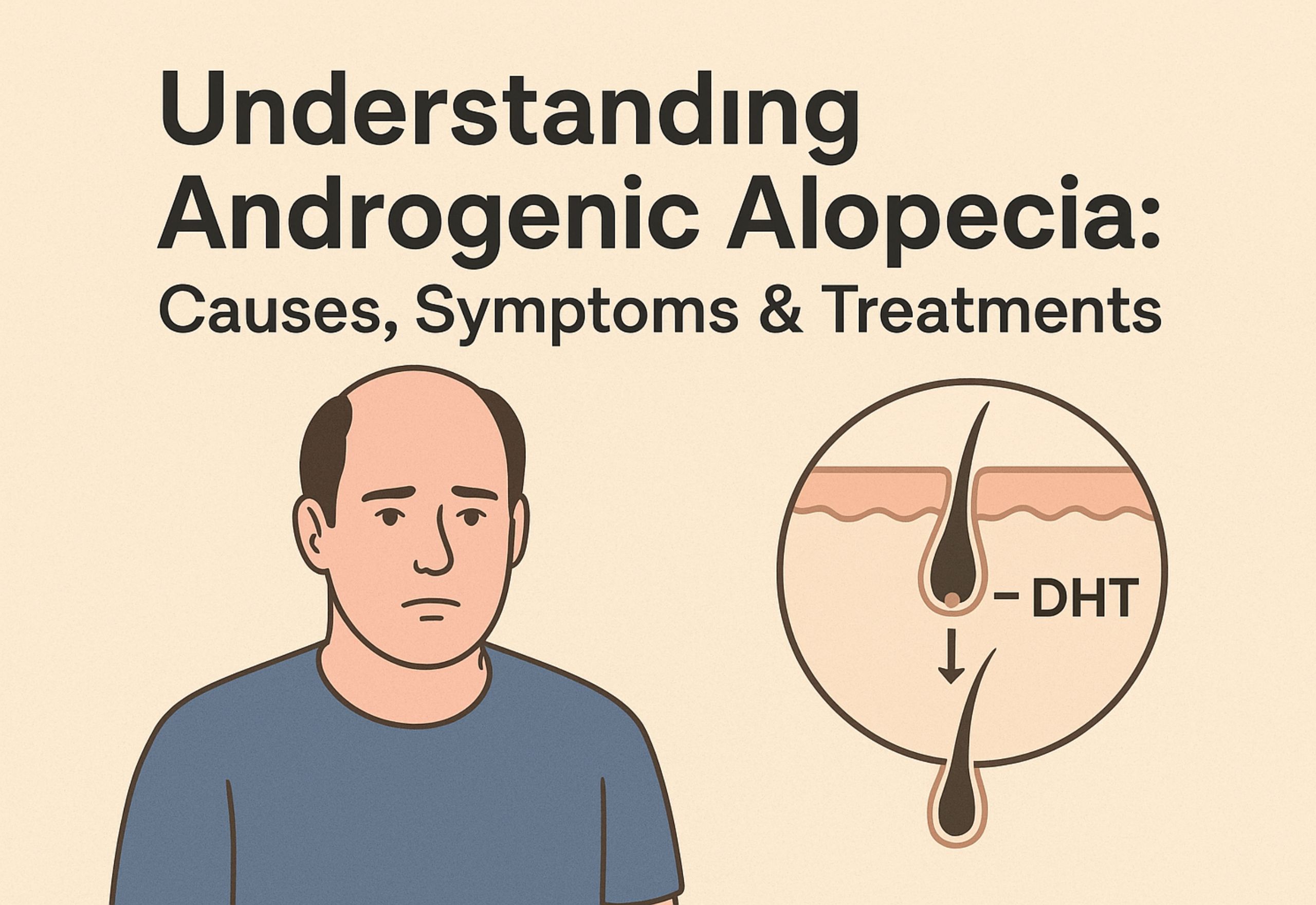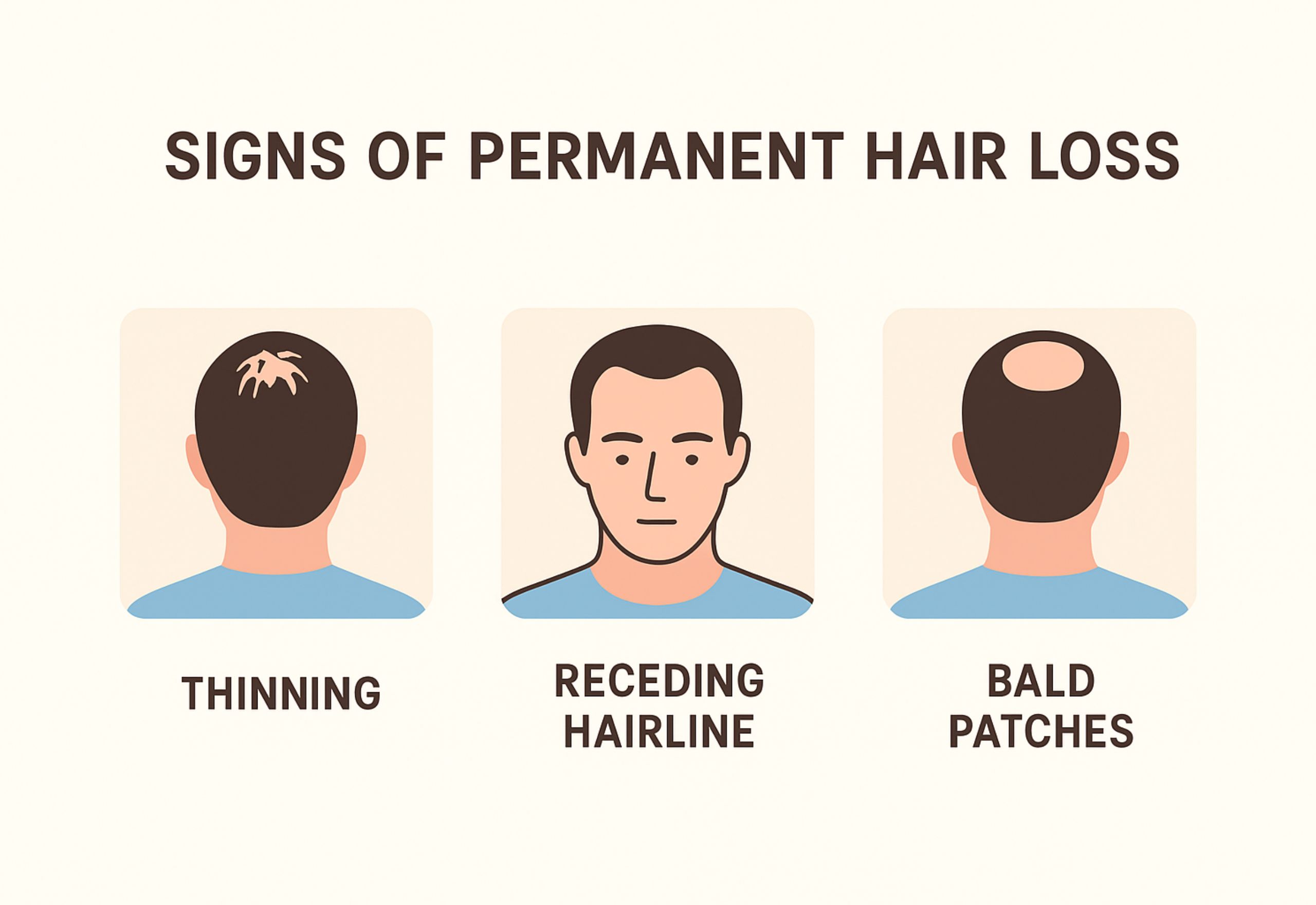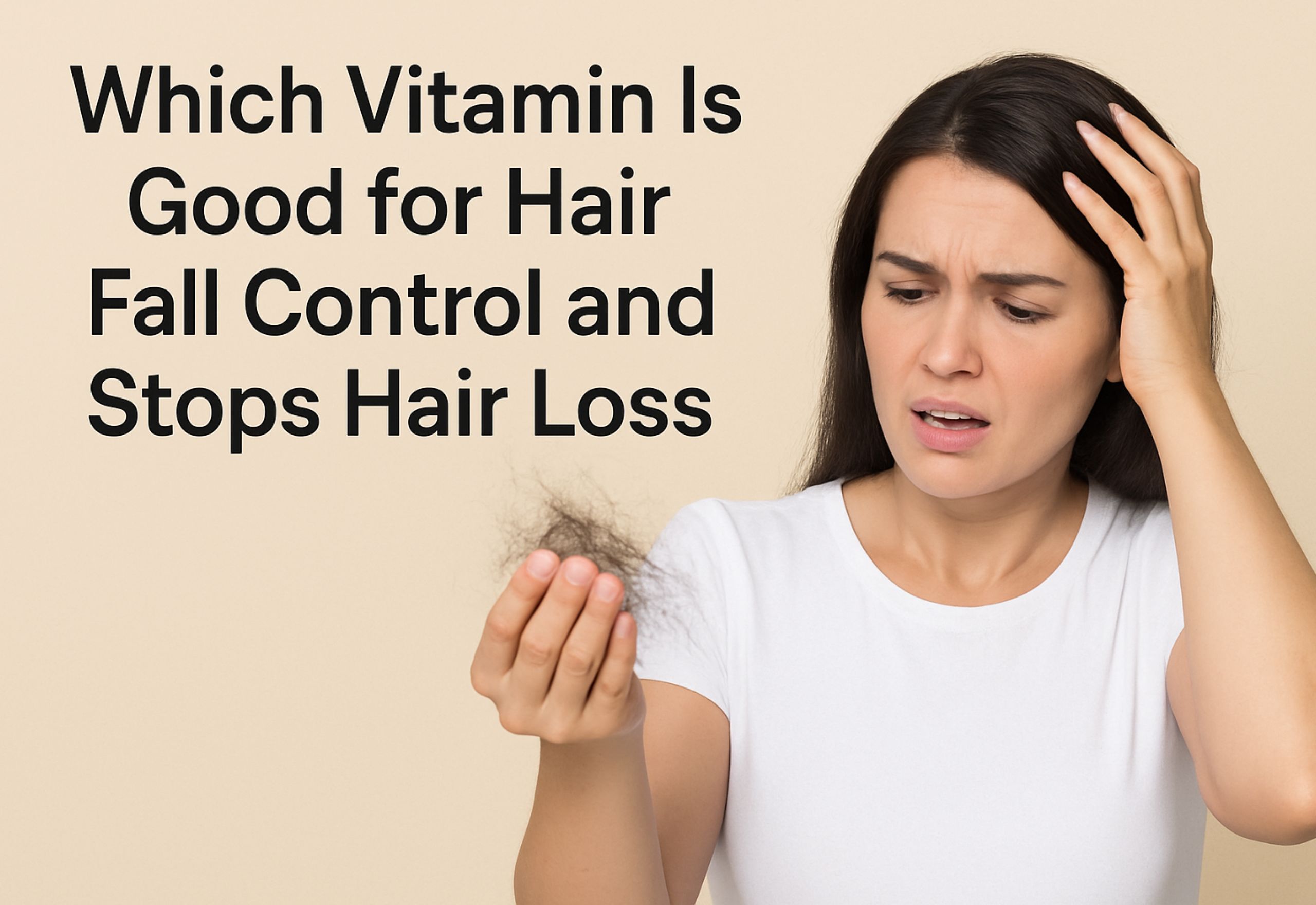Hair has a significant impact on the confidence and self-esteem of a person; that is why hair loss is always so difficult to handle. Androgenetic Alopecia, which is also referred to as male-pattern or female-pattern baldness, is the leading cause of gradual thinning that is behind most cases. The causes of Androgenetic Alopecia constitute a significant part of the genetics, hormones, and aging combination, with dihydrotestosterone (DHT) as a leading factor for the hair follicles getting weaker and smaller over time. Realizing the cause and development of the disease is the first step to the proper treatment.
What is Androgenetic Alopecia?
Androgenetic Alopecia is a degenerative condition that leads to hair loss and is found in both male and female patients, but the symptoms vary between the two sexes. Males generally experience the condition as hairline recession and thinning at the crown, whereas females commonly have the disease as general thinning at the scalp with no noticeable hairline recession.
As the name suggests, “androgenic” relates to a group of hormones known as androgens, while “alopecia” indicates hair loss. Androgens such as dihydrotestosterone (DHT) are among the main elements that control the growth of hair. If the hair follicles are genetically sensitive to these hormones, then the duration of the hair growth cycle will be decreased, resulting in thinning and a lighter texture over time.
The Causes of Androgenetic Alopecia
While investigating Androgenetic Alopecia, scientists have uncovered that it is mainly caused by three factors: heredity, hormonal changes and aging.
- Genetics: One of the most potent predictors of Androgenetic Alopecia is the family history of the individual. The genes decide the sensitivity of the hair follicles to androgens, particularly to DHT, thereby increasing the chances of patterned hair loss being repeated through the generations.
- Hormonal Influence: DHT is the one that attaches to the scalp follicles, and hence, the process of miniaturisation begins. Due to this, follicles become smaller and lighter in color, producing thinner and thinner strands.
- Aging: The hair growth cycles become longer and slower as one ages. If this is merged with the hormonal changes and genetic predispositions, aging will become the leading cause of hair thinning.
- Secondary Factors: Stress, bad diet, scalp inflammation, and illness, which make the body weak, are some of the factors that directly lead to hair thinning. Even though they are not the main reasons for hair loss, these elements can still exacerbate the damage to the follicles.
Identifying the causes of Androgenetic Alopecia not only aids in timely diagnosis but also helps in customizing the treatment plan that fits you best.
Symptoms and Patterns of Androgenetic Alopecia
Hair loss due to shrinking hair follicles happens to both males and females. Identifying these changes at an early stage is very important in deciding the proper treatment for Androgenetic Alopecia before the condition deteriorates further.
In Men:
- Receding hairline: The receding hairline usually starts at the temples and thus forms an “M” shaped pattern.
- Crown thinning: The hair on the top of the head is gradually thinning.
- Advanced baldness: As time goes on, these areas come together, so that the sides and the back of the head are the only places where one can find hair.
In Women:
- Diffuse thinning: The hair gets thinner over the whole scalp, and there are no bald patches.
- Widening part line: One can easily notice that the central parting line is getting wider.
- Hairline preservation: The frontal hairline in women is usually kept intact.
The process of symptom worsening is gradual and may span over several years. This slow pattern usually leads to individuals not consulting a doctor until significant hair loss has occurred.
Diagnosis of Androgenetic Alopecia
Usually, the doctors employ a physical examination, medical history, and diagnostic instruments to identify Androgenetic Alopecia, which will be their first step in providing the necessary treatment for Androgenetic Alopecia.
- Scalp Examination: A dermatologist identifies the kinds of hair loss and miniaturization that can occur.
- Trichoscopy: The use of a dermatoscope allows one to see the health of the follicles and the density of the hair.
- Blood Tests: These might be performed to exclude other causes of hair loss, e.g., thyroid dysfunction, iron deficiency, or hormonal imbalance, that imitate alopecia, although they are not always needed.
Treatment for Androgenetic Alopecia
While a definite cure is not available, modern science provides multiple encouraging choices for hair loss management.
1. Medications
- Minoxidil (Topical): a generally safe and easily accessible, over-the-counter, FDA-approved solution for both women and men that invigorates the hair follicles and thus leads to thickness continuity when used consistently over time.
- Finasteride (Oral): A medicine given to men with a prescription that brings about a drop in DHT levels and thus less shrinkage of hair follicles. It is not generally recommended for women because it can interfere with their hormones.
2. Hair Transplantation
Surgical methods such as Follicular Unit Transplantation (FUT) or Follicular Unit Extraction (FUE) involve taking healthy hair follicles from the donor site and implanting them in the areas that have been going thin.
3. Platelet-Rich Plasma (PRP) Therapy
PRP is the blood plasma of patients, which is enriched with growth factors. The plasma injection into the scalp stimulates follicles and an improvement in density.
4. Low-Level Laser Therapy (LLLT)
The use of laser combs and helmets emits the red light, which increases blood flow and hence provides the necessary cellular activity for the hair follicles.
5. Lifestyle and Nutritional Support
The provision of a nutrient-rich diet, the management of stress, and the maintenance of scalp health can indeed assist the progression of medical treatments; however, they cannot replace the clinical interventions altogether.
Most of the time, a dermatologist will use more than one method. It is more efficient to use a customized Androgenetic Alopecia treatment plan.
Psychological and Emotional Impact
Androgenetic Alopecia is associated with severe psychological symptoms. Research has shown the correlation between hair loss and the drop in self-esteem, the feeling of alienation from society, and the potential development of anxiety or depression.
In men, the condition of going bald is usually associated with the signs of getting old and the loss of male characteristics. Hair thinning can be a down point for females because the culture puts a lot of emphasis on long and healthy hair as a symbol of womanhood.
Caring therapy, patient instruction, and the work of support groups can increase emotional burden. Opting for psychological care with the correct treatment for Androgenetic Alopecia represents a more comprehensive approach to patient care.
Preventive Strategies and Early Care
Genetic predispositions are something you cannot avoid. However, if you receive the proper treatment in the early stage of the illness, you can slow its development and get the maximum benefits from it.
- Regular Scalp Checkups: A visit to a dermatologist at the very first signs of thinning is the most effective way.
- Gentle Hair Care: Less heat for styling, a decrease in the use of harsh chemicals and avoiding tight hairstyles that put pressure on the hair follicles.
- Balanced Nutrition: Ensuring the consumption of the right amounts of protein, vitamins, and minerals is necessary for the growth of healthy hair.
- Stress Reduction: Yoga, meditation, and physical activities as a trio are the most effective means of stress relief. They energize both the mind and the body and lessen the hormone cortisol level in the bloodstream, thus making the hair grow indirectly.
People are more likely to take preventive measures and seek treatment on time if they know the causes of Androgenetic Alopecia.
Research and Future Developments
Inventors are seeking new ways to treat hair loss, which may include the following technologies:
- Stem Cell Therapy: The stem cells are to be used for the regeneration of the damaged hair follicles.
- Wnt Pathway Modulators: Medications that target the signaling pathways to control hair growth of the follicles.
- Gene Therapy: The research is focused on modifying genes that lead to the production of DHT.
- Exosome Therapy: The first clinical trial is to use stem cell-derived exosomes, tiny vesicles equipped with cell signalling molecules, to regrow human hair.
The treatment for Androgenetic alopecia is still in the experimental stage; however, it is a scenario of a bright future for those who are suffering from Androgenetic Alopecia.
Coping with Lifestyle Adjustments
Not all people go for aggressive medical or surgical procedures. There are some who accept their changed look by choosing:
- Hairstyling Changes: Artistic cuts, wigs, or hairpieces to cover the thinning of hair.
- Shaving the Head: A lot of men get a sense of power from a neat, shaven look.
- Beauty Aids: Volumizing shampoos, hair fibers, and scalp concealers are a few temporary solutions.
Conclusion
Androgenetic Alopecia is a typical case where hereditary factors, hormones and the aging process have an impact and affect millions of people. Present-day means like drugs, treatments, and changes in lifestyle have the potential of retarding the progression of the disease. Early identification of causes and prompt administration of treatment for Androgenetic alopecia are indispensable in ensuring not only the hair’s health but also that of the mind.
FAQs
- Can lifestyle have an impact on the development of Androgenetic alopecia?
Yes, several unhealthy lifestyle habits like smoking, overdrinking, eating bad food, and lack of sleep might lead to hair losing more of its volume.
- Are natural remedies sufficient to reverse Androgenetic Alopecia?
The use of natural remedies such as essential oils, scalp massages and herbal supplements can result in strengthening the hair, but they cannot completely reverse Androgenetic Alopecia without consultation.
- Is Androgenetic alopecia the cause of beard and body hair loss, as well?
Androgenetic alopecia is a selective disorder that targets scalp hair follicles, which are sensitive to dihydrotestosterone. Beard and body hair growth are not affected by this condition.
- Does Androgenetic alopecia vary by season?
Some people say that their hair loss becomes severe during a change of season, particularly in autumn. However, these cycles are temporary and not the same as the eventual progression of Androgenetic Alopecia.
- Can a pregnancy be a cause of Androgenetic alopecia or make it worse in a woman?
Hormones during a pregnancy are responsible for a temporary increase in shedding or a delay in hair regrowth.
- Does frequent shampooing accelerate Androgenetic Alopecia?
Frequent washing with shampoo does not cause Androgenetic Alopecia or exacerbate the existing condition.
- Is stress-induced hair loss the same as Androgenetic Alopecia?
Hair loss from stress is referred to as telogen effluvium, which can be reversed, unlike Androgenetic Alopecia, which is a progressive one.
- Is it possible that specific hairstyles make thinning of hair more visible in Androgenetic alopecia?
Of course, some hairstyles emphasize the tearing of the hair, such as ponytails, braids, or cornrows, which can lead to traction alopecia.
- Do environmental pollutants contribute to Androgenetic Alopecia?
Pollutants are not the main factor for Androgenetic Alopecia. But polluted air and water that contain toxic substances can affect the scalp.
- Can weight fluctuations affect Androgenetic alopecia progression?
Indeed, the rapid weight loss or the sudden weight gain affects hormone levels and nutrient balance, which may lead to hair thinning at a faster rate.



